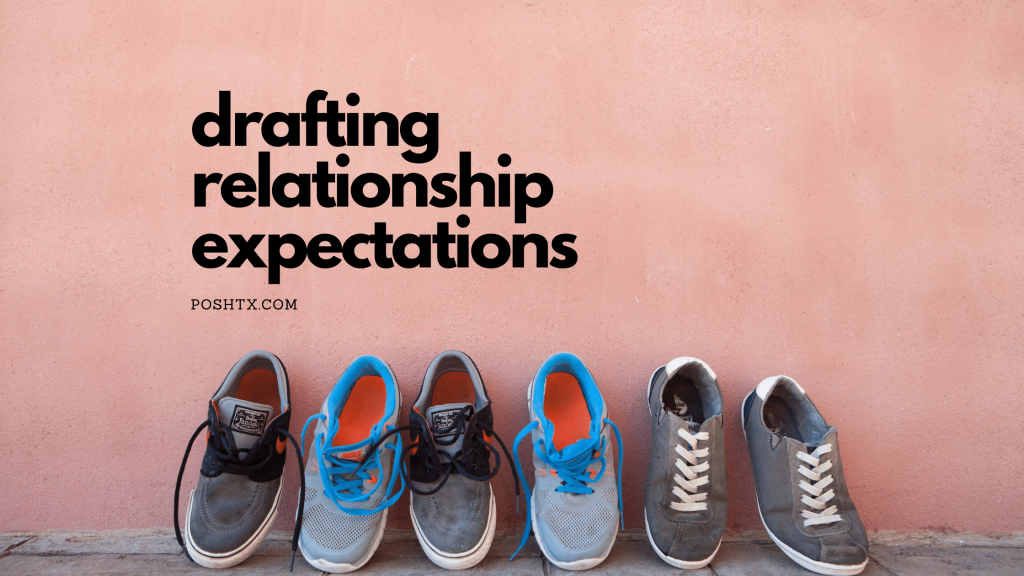
Several years ago, I was working with a wonderful therapist who really helped me to grow and understand more about myself, and what I want and deserve to receive from my relationships. He had me work on creating a Relationship Expectation document that was mostly for my eyes only – it was more an exercise in learning about myself and what I truly want than it was writing up a contract I expected partners to sign.
Each individual should know what their own boundaries and expectations are with the people they care about, but we often don’t think about these in explicit terms or use explicit language to communicate them. Implied agreements lead to misunderstandings and miscommunications. Direct communication can seem intimidating at first but is very rewarding once you become more comfortable with it.
Identity Statement
When I started writing my Relationship Expectations document with the help of a therapist, I started with an identity statement.
I, (NAME), have drafted this document, last revised on (DATE), in an effort to promote clear communication and understanding with my intimate circle of what my expectations, interests, needs, and wants are within my relationships. It will include multiple parts, such as defining terms, outlining personal goals, and expectations of behavior.
I identify as a (SEXUAL ORIENTATION) (GENDER), a (KINSEY NUMBER) on the Kinsey scale, who practices (TYPE OF RELATIONSHIP), leaning more towards (REFINED RELATIONSHIP MODEL LABELS) as a model of relating. What do those terms mean to me? What additional terms are helpful when discussing my methods of relating?
Glossary of Terms
Everyone defines the various labels we use slightly differently, so it’s important to clearly identify what YOU mean when you use a term to describe yourself. My glossary included definitions for all the bolded items in the 2nd quoted paragraph above – what is my sexuality and gender? What kind of ethical non-monogamy do I want to practice? I included definitions for bisexual, the Kinsey scale, Polyamory, Hierarchical Polyamory, Non-Hierarchical Polyamory, Solo Polyamory, Relationship Fluidity, Relationship Anarchy, Fluid Bonding, Safer Sex Practices, STI disclosure to partners, and Disclosure of any personal information to 3rd parties. Everyone’s glossary is going to look a little different.
Pro Tip:
Many of these terms can be found in our Incomplete Guide to Polyam Terms.
Table of Needs and Wants
Needs are the must-haves. They are the things that are non-negotiable in the relationship you’re seeking. Wants are the things that you’re willing to compromise on or may not need every relationship to include.
| NEEDS | WANTS |
| Sexual Compatibility (Which means sex is on the table but doesn’t have to happen all the time) | Kink Compatibility |
| Other Points of Compatibility (common interests/beliefs) | Gets along with Metas & other important folks in my life |
| Understanding of consent culture | Driven to improve themselves and grow |
| Polyamorous | Lives close enough for spontaneity |
| Up-front, direct and honest | |
| Committed to having integrity | |
| Communicative without being clingy | |
| Available to spend time together |
Goals and Aspirations
Outside of our relationships, everyone has goals, dreams, ideas, and desires that overlap with our interpersonal relationships. In this section, I wrote briefly about having to travel for work, and my teenage children, and the fact that sometimes they take priority over everything else, so anyone wanting to become part of my life needs to be aware of that. Seems obvious, right? You might be surprised. I then outlined with bullet points what my professional, personal, and political goals are. These points might be different for you, but it’s important to think of yourself as a whole person, not just a partner in a relationship.
Tiers of Connection
My therapist wanted me to think about relationships as tiers. I used a bar graph to represent the level of entanglement, but you could use a pie chart or a bullseye of overlapping circles.
Each type of connection has a tier of involvement or commitment that is unique. The graph below shows what my “tiers of connection” are, and I will describe what I expect from each tier type on the next page. I don’t view this as the same as a hierarchy of primary/secondary so much as a realistic expectation of my time and emotional investment into relationships. These tiers don’t necessarily mean one tier is more important in any given moment than another, but that each need is taken individually into account on the terms of that individual relationship, and my available bandwidth at that time.
These are meant as a reference only and should be rewritten to reflect your own Tiers of Connection based on your own relationship needs.
My Tiers of connection:
- Casual Acquaintances – A person I am friendly with who seems to be outwardly decent and has a positive reputation.
- Hookup/Satellite – A casual acquaintance I have a sexual relationship with.
- Friends – Began as A, plus has qualities about them that I admire and enjoy.
- Friends with Benefits – Began as A or B, includes C but has a more regular or recurring sexual component without the commitment or emotional attachment of E.
- Close Friend/Intimate Partner – Began as A or B, progressed to C or D, but includes a commitment to spend time together regularly, a much deeper level of trust, and expectations of honesty and integrity.
- A Life Partner – Selections from all of the above options, plus additional voluntary entanglement through combined finances, cohabitation, children, etc.
Expectations of behavior for myself and my partners
In the next section, I laid out what I agreed to do for each type of connection, and what I expected of them in return. This is not a contract, it’s just a starting place for negotiation. You don’t have to have this piece of paper in front of you when you have the discussion with your potential partner, but preparing it beforehand will help you be clear in your thinking and your decision-making when compromises are necessary.
Integrity is a big deal for me. My goal in defining these expectations in writing is to promote greater understanding and communication with regard to personal boundaries involving privacy, disclosure, safety, and informed consent. In making this list of expectations, I am focusing on intimate partnerships and not other types of relationships. You could easily translate this into a way to set boundaries for other types of relationships.
At this point, I made a new heading for each type of relationship listed above, with an “I will” subheading and bullet points below, followed by a section where “In return, I expect the following from my partners” beginning with the least committed connection type to the most committed connection type. You’ll see in the examples below that I used shorthand to convey some of the overlapping expectations as the levels of commitment and entanglement increased.
Example – Least committed: Expectations with casual, short-term hook-ups and satellite partners:
- I will:
- Be honest with you about my feelings and what I want from our connection
- Maintain a regular testing schedule of at least yearly STI screening and disclose the results of that testing to you.
- Only engage in safer sex practices as defined above
- Not initiate or engage in first-time sexual encounters while intoxicated, as informed, sober consent is necessary for me when establishing a new sexual relationship, even if it is a one-time casual connection.
- Not seek to control you or your bodily or sexual autonomy
- In return, I expect the following from my partners:
- Be honest with me about your feelings, and be direct about what you want out of our connection.
- Maintain a regular testing schedule of at least yearly STI screening and disclose the results of that testing to me before we engage in sex if you’ve had new testing since the last time we had sex.
- Respect that consent is necessary for more than just a sexual context, and that it is revocable at any time.
- Do not ask me to have unprotected sex with you or tell me about fantasizing about having unprotected sex with me.
- Be tactful but honest with me, without intending deception or manipulation.
- Respect my bodily and sexual autonomy and do not seek to control me through sex negativity, slut-shaming, or misogyny.
Example – Most committed: Expectations with Life-Partners: I will:
- Promise the same as in 1.a-1.e above.
- Honesty, Testing/Disclosure for sex partners, Safer Sex, Sober Consent, Agency
- Promise the same as in 2.b-2.e above
- conflict resolution, communicate availability, Fluid Bonding, keeping confidences
- Promise the same as in 5c – 5d above
- Disclose risk events, disclose new partners
- Voluntarily contribute to joint financial interests, such as owning property, cohabitation, or raising children
- In return, I expect the following from my partners:
- Promise the same as in 2.a-2.f above.
- Honesty, Testing/Disclosure for sex partners, Safer Sex, Sober Consent, Agency, Consent Awareness, Don’t Fetishize Unprotected sex, Don’t manipulate me
- Promise the same as in 2.b-2.e above
- conflict resolution, communicate availability, Fluid Bonding, Honor Commitments
- conflict resolution, communicate availability, Fluid Bonding, Honor Commitments
- Promise the same as in 6c – 6d above
- Disclose risk events, disclose new partners
- Voluntarily contribute to joint financial interests, such as owning property, cohabitation, or raising children
Closing
This should provide you with a framework to help you be mindful and intentional about practicing ethical non-monogamy, but it’s important to check in regularly with your partners once you’ve made your agreements so you can be sure you’re still on the same page.
